[press release; translated by Google]
Forest and heather birds in the lead on new stamps
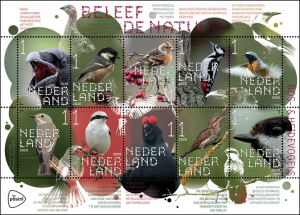 The Hague, September 14, 2020. On the latest stamp sheetlet from the “Experience nature” series, forest and heather birds play the leading role. The ten depicted birds on the stamps are the raven, coal tit, keep, great spotted woodpecker, red-collared redstart, greylag flycatcher, gray shrike, black grouse, wryneck and rump head. [Larger illustration of full sheet at end]
The Hague, September 14, 2020. On the latest stamp sheetlet from the “Experience nature” series, forest and heather birds play the leading role. The ten depicted birds on the stamps are the raven, coal tit, keep, great spotted woodpecker, red-collared redstart, greylag flycatcher, gray shrike, black grouse, wryneck and rump head. [Larger illustration of full sheet at end]
Earlier this year, PostNL already issued stamps about birds of prey and owls (January 2), farmland birds (February 24) and shorebirds (June 15). The stamp sheetlet about forest and heather birds is the last of this year in this series. In individual sales, each stamp 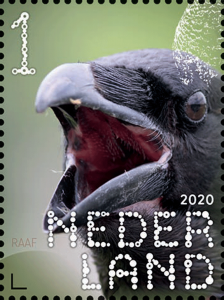 sheetlet “Experience nature” costs € 9.10. The price for the full series 2020 is € 36.40, including storage folder.
sheetlet “Experience nature” costs € 9.10. The price for the full series 2020 is € 36.40, including storage folder.
Polished away
The stamps were designed by graphic designer Frank Janse from Gouda. In most birds it also shows a part of their natural habitat, such as a tree trunk or branch. “For example, the gray shrike sits on a twig with thorns,” says Janse. “The Gray Shrike is a shrike and shrike have a habit of impaling their prey, such as smaller birds or mice, alive on a twig or thorn for later eating. In the original photo, a mouse was also pinned next to the gray shrike. I just brushed it away.”
Red accents
The colors in the photos play an important role in connecting the stamps by blending the backgrounds. It was mainly a matter of selection and arrangement, because the designer did not want to manipulate the original colors out of respect for the photographer and 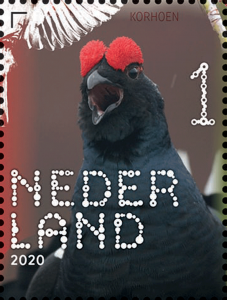 nature. Janse: “It has become a beautiful autumnal sheet with a mossy green in the background, which fits exactly with this season. In the center of the sheet, red accents draw the attention: the background by the gray shrike, the eyebrows of the black grouse, the berries at the keep and the “pants” of the great spotted woodpecker.”
nature. Janse: “It has become a beautiful autumnal sheet with a mossy green in the background, which fits exactly with this season. In the center of the sheet, red accents draw the attention: the background by the gray shrike, the eyebrows of the black grouse, the berries at the keep and the “pants” of the great spotted woodpecker.”
Bird Protection Netherlands
The stamps show bird species that are having a particularly difficult time. Most of them are on the Red List of breeding birds in the Netherlands or on the Red List of migrants / hibernators in the Netherlands. Resi Becker, Mail NL director of PostNL, says that it is indeed not going well with the birds in our country. “For example, the Red List of breeding birds contains 87 bird species. That is 44 percent of all species that breed in our country. Ten species are critically endangered, such as the short-eared owl and the little bittern. So it is great to draw attention to this with the issue of this stamp.”
Heather birds in danger zone
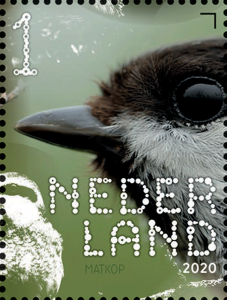 Heather birds in particular have a difficult time in our country due to the deterioration in the quality of heathland areas and the sharp decrease in the number of insects. Many bird species have therefore entered the danger zone. The black grouse, for example, is on the verge of disappearing. The wheatear can hardly be found on heaths anymore, but it can still be found in dune areas. The gray shrike only occurs as a winter guest in our country.
Heather birds in particular have a difficult time in our country due to the deterioration in the quality of heathland areas and the sharp decrease in the number of insects. Many bird species have therefore entered the danger zone. The black grouse, for example, is on the verge of disappearing. The wheatear can hardly be found on heaths anymore, but it can still be found in dune areas. The gray shrike only occurs as a winter guest in our country.
Availability
The stamp sheet “Experience nature – forest & heather birds” consists of 10 different stamps with the value indication Nederland 1, intended for mail up to 20 grams with a destination within the Netherlands. The stamps will be available from September 14, 2020 at all PostNL points of sale, Bruna stores and via the website [direct link]. The stamps can also be ordered by telephone from the Collect Club customer service on telephone number 088 – 868 99 00. The period of validity is indefinite.
[in de Nederlandse taal]
Bos- en heidevogels in de hoofdrol op nieuwe postzegels
Den Haag, 14 september 2020. Op het nieuwste postzegelvel uit de serie ‘Beleef de natuur’ spelen bos- en heidevogels de hoofdrol. De tien afgebeelde vogels op de postzegels zijn de raaf, zwarte mees, keep, grote bonte specht, gekraagde roodstaart, grauwe vliegenvanger, klapekster, korhoen, draaihals en matkop.
Eerder dit jaar bracht PostNL al postzegels uit over roofvogels en uilen (2 januari), boerenlandvogels (24 februari) en kustvogels (15 juni). Het postzegelvel over bos- en heidevogels is de laatste van dit jaar uit deze serie. In de losse verkoop kost elk postzegelvel ‘Beleef de natuur’ € 9,10. De prijs voor de volledige serie 2020 is € 36,40, inclusief bewaarmap.
Weggepoetst
De postzegels zijn ontworpen door grafisch ontwerper Frank Janse uit Gouda. Bij de meeste vogels laat hij ook een deel van hun natuurlijke leefomgeving zien, bijvoorbeeld een boomstam of tak. “Zo zit de klapekster op een takje met doornen”, vertelt Janse. “De klapekster is een klauwier en klauwieren hebben de gewoonte om hun prooien, zoals kleinere vogels of muizen, levend vast te spietsen op een takje of een doorn om ze later te kunnen opeten. Op de oorspronkelijke foto zat ook een muisje opgeprikt naast de klapekster. Die heb ik maar weggepoetst.”
Rode accenten
De kleuren op de foto’s spelen een belangrijke rol om de postzegels met elkaar te verbinden door de achtergronden in elkaar te laten overlopen. Het is vooral een kwestie van selecteren en rangschikken geweest, want de ontwerper wilde uit respect voor fotograaf en natuur de oorspronkelijke kleuren niet manipuleren. Janse: “Het is een mooi herfstig velletje geworden met een mossig groen op de achtergrond, wat precies bij dit jaargetijde past. In het midden van het vel trekken rode accenten de aandacht: de achtergrond bij de klapekster, de wenkbrauwen van het korhoen, de besjes bij de keep en de ‘broek’ van de grote bonte specht.”
Vogelbescherming Nederland
Op de postzegels komen vogelsoorten voor die het bijzonder moeilijk hebben. De meeste staan op de Rode Lijst van broedvogels in Nederland of op de Rode Lijst van doortrekkers/overwinteraars in Nederland. Resi Becker, directeur Mail NL van PostNL, vertelt dat het inderdaad niet goed gaat met de vogels in ons land. “Zo staan op de Rode Lijst van broedvogels 87 vogelsoorten. Dat is 44 procent van alle soorten die in ons land broeden. 10 soorten zijn ernstig bedreigd, zoals de velduil en de woudaap. Mooi om dus met de uitgifte van deze postzegel daar aandacht voor te vragen.”
Heidevogels in gevarenzone
Met name de heidevogels hebben het in ons land moeilijk door de achteruitgang van de kwaliteit van heidegebieden en de sterke afname van het aantal insecten. Veel vogelsoorten zijn daardoor in de gevarenzone gekomen. Het korhoen staat bijvoorbeeld op de rand van verdwijnen. De tapuit is nauwelijks meer op heidevelden te vinden, maar nog wel in duingebieden. De klapekster komt alleen nog als wintergast voor in ons land.
Verkrijgbaarheid
Het postzegelvel ‘Beleef de natuur – bos- & heidevogels’ telt 10 verschillende postzegels met de waardeaanduiding Nederland 1, bedoeld voor post tot en met 20 gram met een bestemming binnen Nederland. De postzegels zijn vanaf 14 september 2020 verkrijgbaar bij alle verkooppunten van PostNL, Bruna-winkels en via de website. De postzegels zijn ook telefonisch te bestellen bij de klantenservice van Collect Club op telefoonnummer 088 – 868 99 00. De geldigheidstermijn is onbepaald.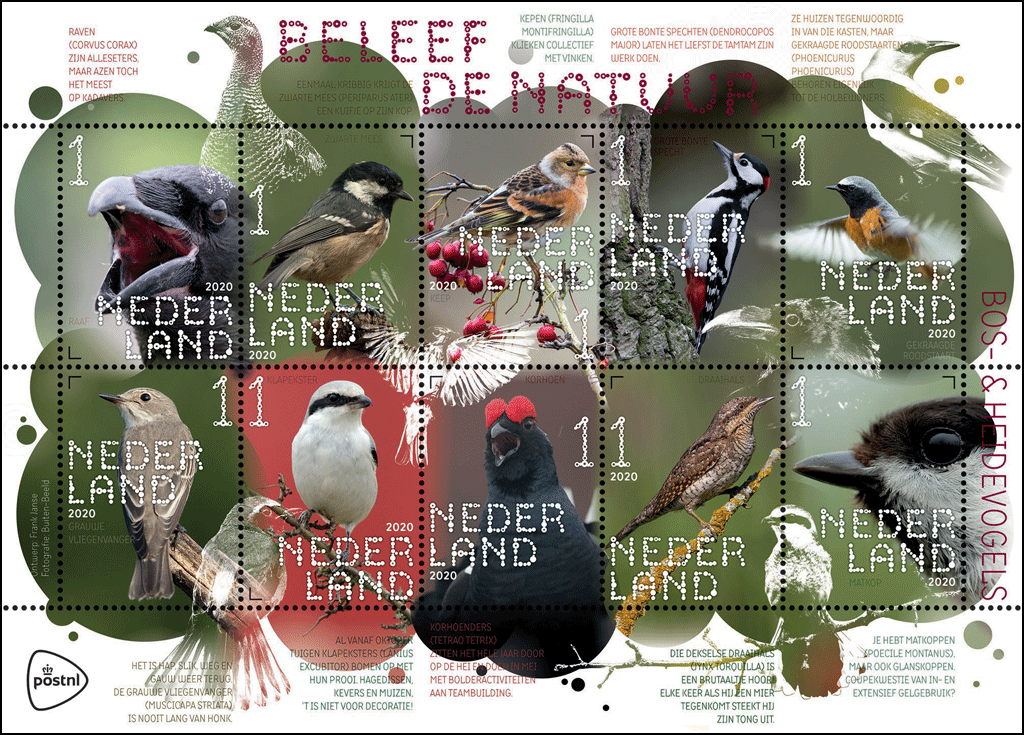
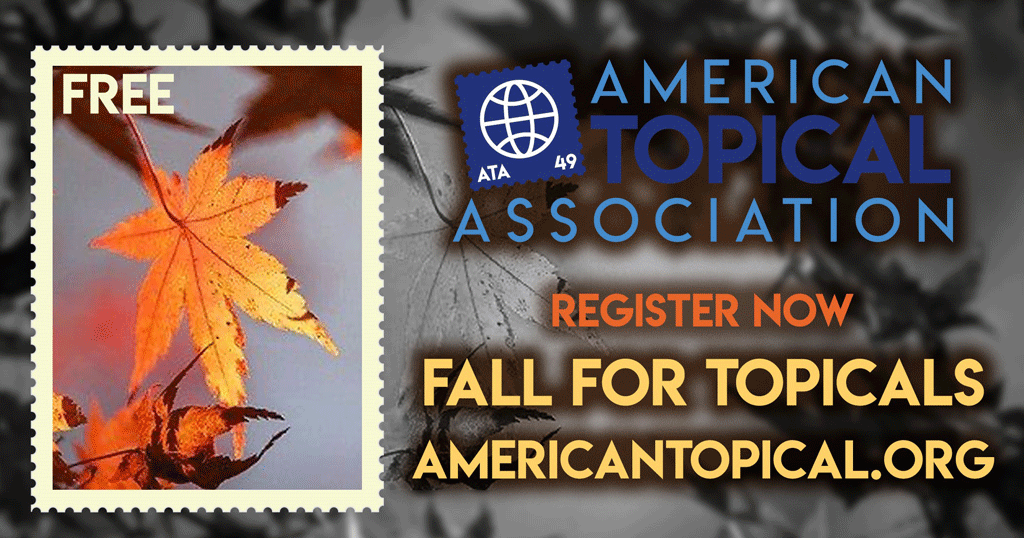 The subjects are:
The subjects are:

 Balfour Mount, M. Vera Peters, James Till and Ernest McCulloch. Their contributions to the fields of pediatric pathology, HIV/AIDS, palliative care, oncology and stem cell science changed the practice of medicine in Canada and around the world.
Balfour Mount, M. Vera Peters, James Till and Ernest McCulloch. Their contributions to the fields of pediatric pathology, HIV/AIDS, palliative care, oncology and stem cell science changed the practice of medicine in Canada and around the world.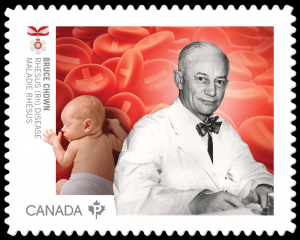 a manageable condition with a near-normal life expectancy and has markedly reduced HIV transmission. Dr. Mount, O.C., O.Q. (b. 1939), considered the father of palliative care in North America, founded the world’s first comprehensive palliative care service based in a teaching hospital. Dr. Peters, O.C.(1911-93) revolutionized treatment for Hodgkin lymphoma and breast cancer in an era when the work of female physician scientists was not often acknowledged. Dr. Till, O.C., O. Ont. (b. 1931) and Dr.
a manageable condition with a near-normal life expectancy and has markedly reduced HIV transmission. Dr. Mount, O.C., O.Q. (b. 1939), considered the father of palliative care in North America, founded the world’s first comprehensive palliative care service based in a teaching hospital. Dr. Peters, O.C.(1911-93) revolutionized treatment for Hodgkin lymphoma and breast cancer in an era when the work of female physician scientists was not often acknowledged. Dr. Till, O.C., O. Ont. (b. 1931) and Dr.  McCulloch, O.C., O. Ont. (1926-2011) transformed the world’s understanding of tissue renewal by establishing the foundations of stem cell science.
McCulloch, O.C., O. Ont. (1926-2011) transformed the world’s understanding of tissue renewal by establishing the foundations of stem cell science. pandemic.
pandemic.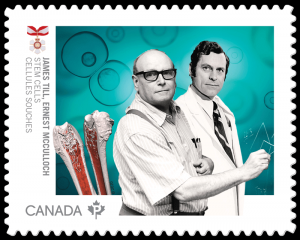 TORONTO, le 14 sept. 2020 /CNW/ – Aujourd’hui, Postes Canada a émis un jeu de cinq timbres commémoratifs célébrant six pionniers de la médecine : la Dre M. Vera Peters, les Drs Bruce Chown, Julio Montaner, Balfour Mount et Ernest McCulloch, et le chercheur James Till. Leurs contributions dans les domaines de l’oncologie, de la médecine pédiatrique, de la recherche sur le VIH/sida, des soins palliatifs et de l’étude des cellules souches ont transformé la pratique de la médecine au Canada et partout dans le monde.
TORONTO, le 14 sept. 2020 /CNW/ – Aujourd’hui, Postes Canada a émis un jeu de cinq timbres commémoratifs célébrant six pionniers de la médecine : la Dre M. Vera Peters, les Drs Bruce Chown, Julio Montaner, Balfour Mount et Ernest McCulloch, et le chercheur James Till. Leurs contributions dans les domaines de l’oncologie, de la médecine pédiatrique, de la recherche sur le VIH/sida, des soins palliatifs et de l’étude des cellules souches ont transformé la pratique de la médecine au Canada et partout dans le monde. Le Dr Chown, O.C., M.C. (1893-1986), a été l’un des premiers dans le monde à éliminer la maladie rhésus (Rh) qui entraînait autrefois la mort de nombreux nouveau-nés. Grâce au Dr Montaner, O.C., O.B.C. (né en 1956), le VIH/SIDA est devenu une maladie chronique gérable, son taux a grandement diminué et les personnes qui en sont atteintes ont maintenant une longévité comparable au reste de la population. Considéré comme le pionnier des soins palliatifs en Amérique du Nord, le Dr Mount, O.C., O.Q. (né en 1939), a
Le Dr Chown, O.C., M.C. (1893-1986), a été l’un des premiers dans le monde à éliminer la maladie rhésus (Rh) qui entraînait autrefois la mort de nombreux nouveau-nés. Grâce au Dr Montaner, O.C., O.B.C. (né en 1956), le VIH/SIDA est devenu une maladie chronique gérable, son taux a grandement diminué et les personnes qui en sont atteintes ont maintenant une longévité comparable au reste de la population. Considéré comme le pionnier des soins palliatifs en Amérique du Nord, le Dr Mount, O.C., O.Q. (né en 1939), a 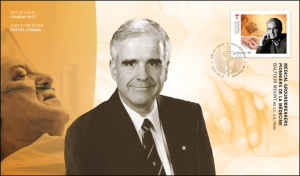 fondé le premier service de soins palliatifs complet au monde dans un hôpital d’enseignement. La Dre Peters, O.C. (1911-1993), a révolutionné le traitement du lymphome de Hodgkin et du cancer du sein à une époque où les femmes chercheures en médecine n’étaient guère reconnues. James Till, O.C., O. Ont. (né en 1931), et le Dr Ernest McCulloch, O.C., O. Ont. (1926-2011), ont transformé la notion de renouvellement des
fondé le premier service de soins palliatifs complet au monde dans un hôpital d’enseignement. La Dre Peters, O.C. (1911-1993), a révolutionné le traitement du lymphome de Hodgkin et du cancer du sein à une époque où les femmes chercheures en médecine n’étaient guère reconnues. James Till, O.C., O. Ont. (né en 1931), et le Dr Ernest McCulloch, O.C., O. Ont. (1926-2011), ont transformé la notion de renouvellement des 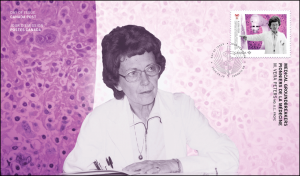 tissus en prouvant l’existence des cellules souches.
tissus en prouvant l’existence des cellules souches.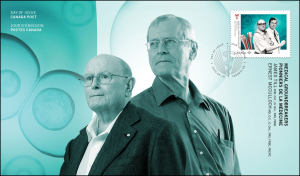
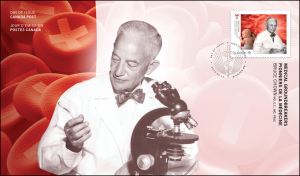 contributions remarquables.
contributions remarquables.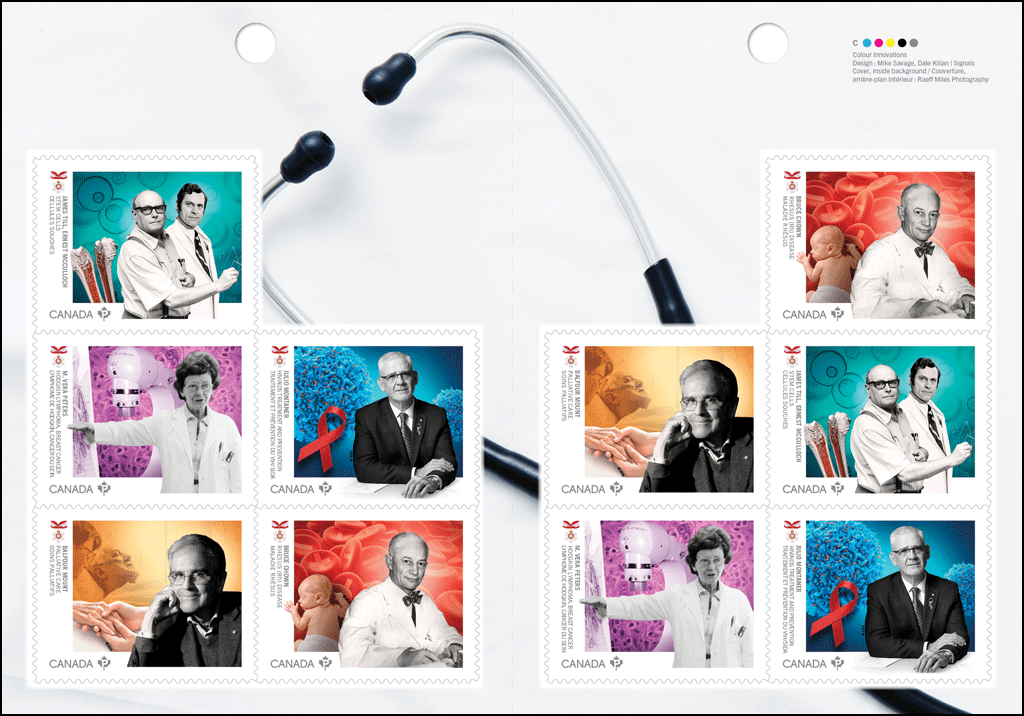

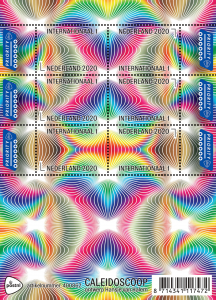 kaleidoscopic patterns. In the cheerful and playful stamp sheetlet full of optical illusions, graphic designer Hansje van Halem, winner of the Dutch Design Award for Communication in 2018, has applied all the colors from the color box. [A larger picture of the full sheet is shown at the end of this page.]
kaleidoscopic patterns. In the cheerful and playful stamp sheetlet full of optical illusions, graphic designer Hansje van Halem, winner of the Dutch Design Award for Communication in 2018, has applied all the colors from the color box. [A larger picture of the full sheet is shown at the end of this page.]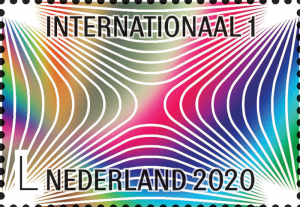 Van Halem started her design by drawing simple lines in a random pattern. “Without a goal, just try it out. For me, drawing equals searching, discovering. You have to look closely at what you are doing to understand what you have done. In the process I try to discover what I want to achieve. For example, I make a lot of endpapers for books and they are of course decorative. There too I look for harmony by creating optical illusions, just as happened with these stamps. ”
Van Halem started her design by drawing simple lines in a random pattern. “Without a goal, just try it out. For me, drawing equals searching, discovering. You have to look closely at what you are doing to understand what you have done. In the process I try to discover what I want to achieve. For example, I make a lot of endpapers for books and they are of course decorative. There too I look for harmony by creating optical illusions, just as happened with these stamps. ”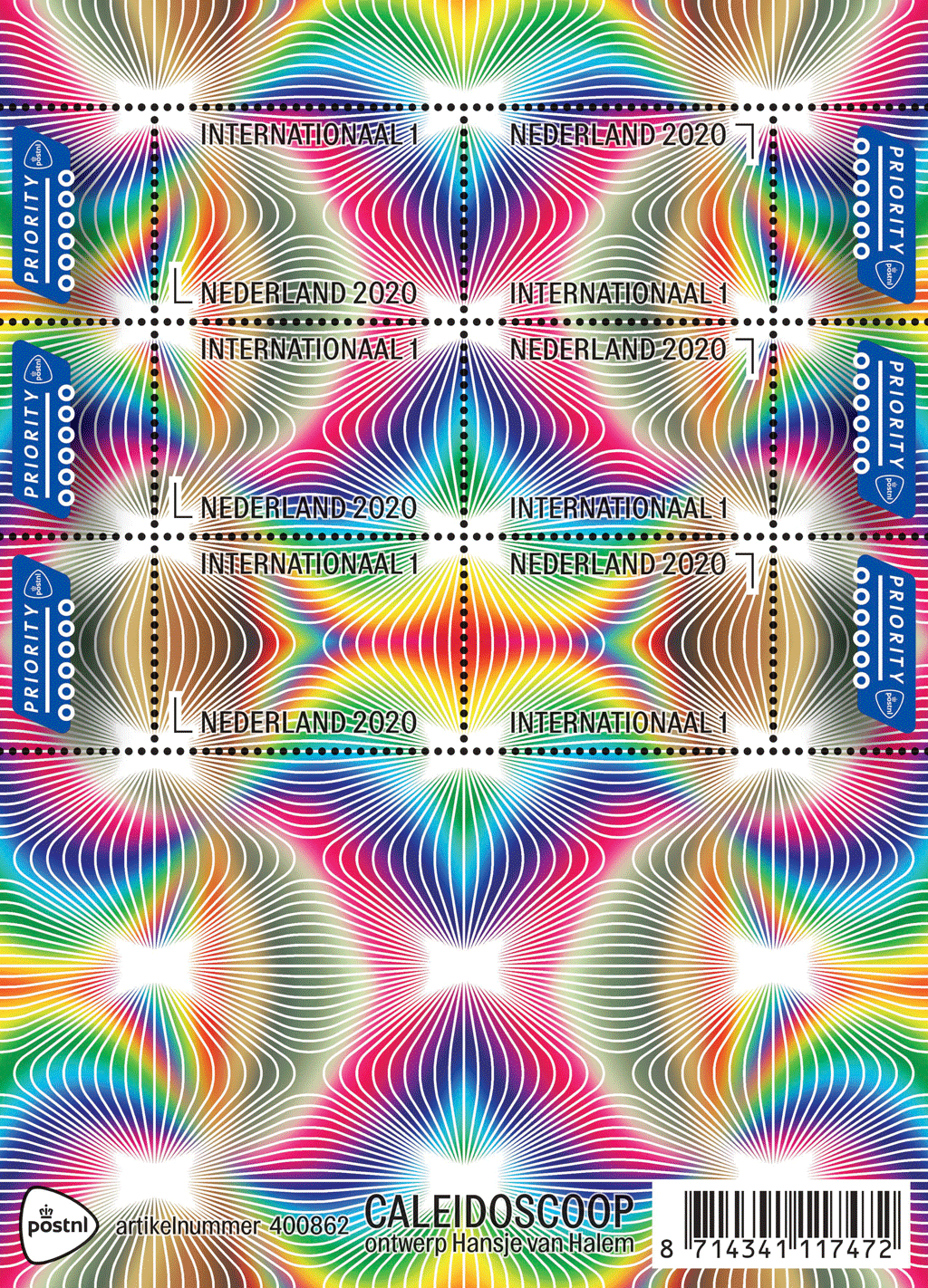
 The Hague, September 14, 2020. On the latest stamp sheetlet from the “Experience nature” series, forest and heather birds play the leading role. The ten depicted birds on the stamps are the raven, coal tit, keep, great spotted woodpecker, red-collared redstart, greylag flycatcher, gray shrike, black grouse, wryneck and rump head. [Larger illustration of full sheet at end]
The Hague, September 14, 2020. On the latest stamp sheetlet from the “Experience nature” series, forest and heather birds play the leading role. The ten depicted birds on the stamps are the raven, coal tit, keep, great spotted woodpecker, red-collared redstart, greylag flycatcher, gray shrike, black grouse, wryneck and rump head. [Larger illustration of full sheet at end] sheetlet “Experience nature” costs € 9.10. The price for the full series 2020 is € 36.40, including storage folder.
sheetlet “Experience nature” costs € 9.10. The price for the full series 2020 is € 36.40, including storage folder. nature. Janse: “It has become a beautiful autumnal sheet with a mossy green in the background, which fits exactly with this season. In the center of the sheet, red accents draw the attention: the background by the gray shrike, the eyebrows of the black grouse, the berries at the keep and the “pants” of the great spotted woodpecker.”
nature. Janse: “It has become a beautiful autumnal sheet with a mossy green in the background, which fits exactly with this season. In the center of the sheet, red accents draw the attention: the background by the gray shrike, the eyebrows of the black grouse, the berries at the keep and the “pants” of the great spotted woodpecker.” Heather birds in particular have a difficult time in our country due to the deterioration in the quality of heathland areas and the sharp decrease in the number of insects. Many bird species have therefore entered the danger zone. The black grouse, for example, is on the verge of disappearing. The wheatear can hardly be found on heaths anymore, but it can still be found in dune areas. The gray shrike only occurs as a winter guest in our country.
Heather birds in particular have a difficult time in our country due to the deterioration in the quality of heathland areas and the sharp decrease in the number of insects. Many bird species have therefore entered the danger zone. The black grouse, for example, is on the verge of disappearing. The wheatear can hardly be found on heaths anymore, but it can still be found in dune areas. The gray shrike only occurs as a winter guest in our country.
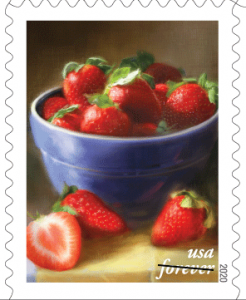 5484 (55¢) Fruits and Vegetables – Red and black plums
5484 (55¢) Fruits and Vegetables – Red and black plums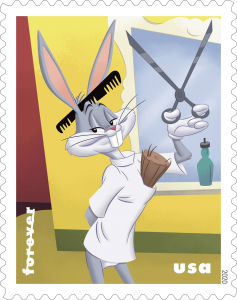 5495 (55¢) Bugs Bunny, 80th Anniv. – Basketball player
5495 (55¢) Bugs Bunny, 80th Anniv. – Basketball player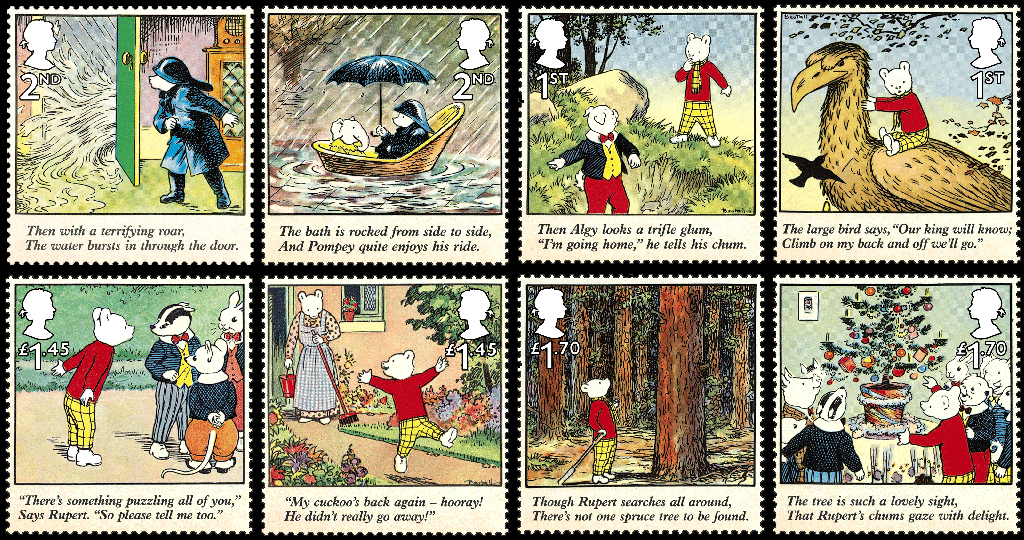
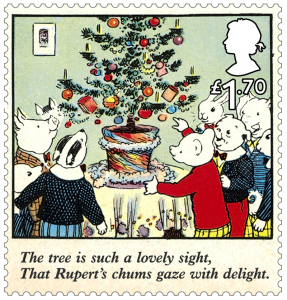 Mare’s Nest (1952), Rupert And The Lost Cuckoo (1963) and Rupert’s Christmas Tree (1947)
Mare’s Nest (1952), Rupert And The Lost Cuckoo (1963) and Rupert’s Christmas Tree (1947)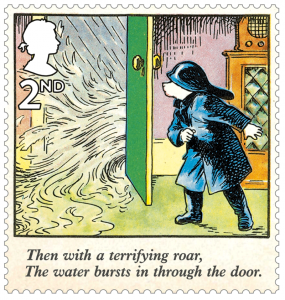 Rupert Bear. The stamps feature the artwork of Alfred Bestall, who wrote and illustrated more than 270 Rupert stories after he took on the role in 1935.
Rupert Bear. The stamps feature the artwork of Alfred Bestall, who wrote and illustrated more than 270 Rupert stories after he took on the role in 1935.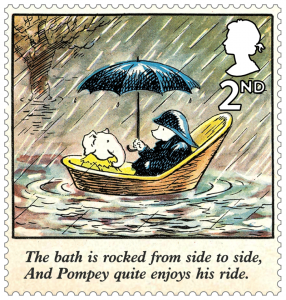 at the Express, and his wife, Mary, was the illustrator.
at the Express, and his wife, Mary, was the illustrator.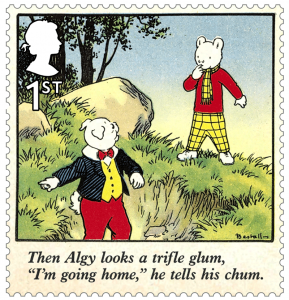 Her replacement was Alfred Bestall, an established artist with Punch and other magazines, who also illustrated children’s books. In total, he wrote and illustrated 224 Rupert stories for the newspaper and provided 47 other stories, mostly for the Rupert Annuals. In 1985 he was awarded the MBE for his work. He died the following year. It is his illustrations which are reproduced on the stamps which feature Rupert in adventures with some of friends including Algy Pup, Bill Badger and Pompey the baby elephant.
Her replacement was Alfred Bestall, an established artist with Punch and other magazines, who also illustrated children’s books. In total, he wrote and illustrated 224 Rupert stories for the newspaper and provided 47 other stories, mostly for the Rupert Annuals. In 1985 he was awarded the MBE for his work. He died the following year. It is his illustrations which are reproduced on the stamps which feature Rupert in adventures with some of friends including Algy Pup, Bill Badger and Pompey the baby elephant.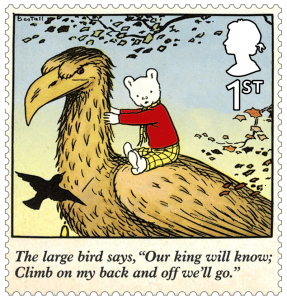 whereby every picture had a rhyming couplet underneath, plus a few lines of story text to accompany them. Bestall’s couplets often ended with the promise of a mystery, so that the next day’s paper was eagerly awaited by children, curious to see how the story would unfold. Bestall also introduced new characters to add variety, including Lily Duckling, Gregory Guineapig, the Old Professor, Bingo and the Imps of Spring and Autumn. Most Rupert stories commence with the bear leaving home and end with him returning after an adventure in time for tea to tell his mother of his experiences.
whereby every picture had a rhyming couplet underneath, plus a few lines of story text to accompany them. Bestall’s couplets often ended with the promise of a mystery, so that the next day’s paper was eagerly awaited by children, curious to see how the story would unfold. Bestall also introduced new characters to add variety, including Lily Duckling, Gregory Guineapig, the Old Professor, Bingo and the Imps of Spring and Autumn. Most Rupert stories commence with the bear leaving home and end with him returning after an adventure in time for tea to tell his mother of his experiences.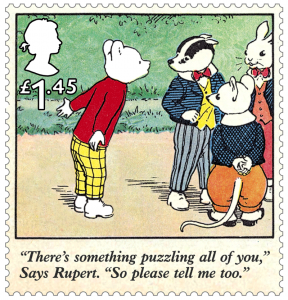 While books of reprinted Rupert stories appeared in the 1920s, it was decided that an annual publication would appear every Christmas. It was titled, Monster Rupert. The first volume was issued in 1931 and continued up to 1934, ceasing after Mary Tourtel retired.
While books of reprinted Rupert stories appeared in the 1920s, it was decided that an annual publication would appear every Christmas. It was titled, Monster Rupert. The first volume was issued in 1931 and continued up to 1934, ceasing after Mary Tourtel retired.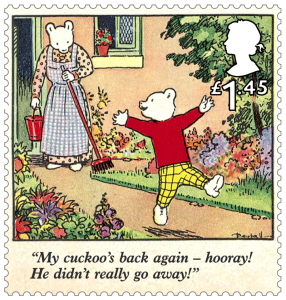 World War, the government sanctioned sufficient paper for the annuals to be printed, to help boost the morale of the public.
World War, the government sanctioned sufficient paper for the annuals to be printed, to help boost the morale of the public.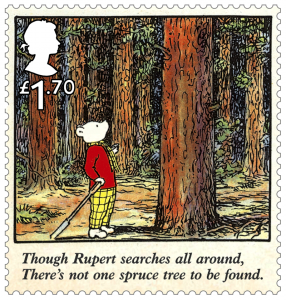 generations of children to a wonderful make-believe world of magic and adventure.”
generations of children to a wonderful make-believe world of magic and adventure.”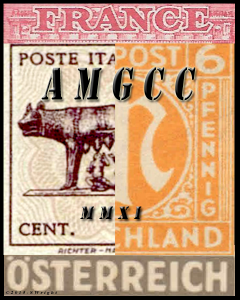 The Allied Military Government Collectors’ Club (AMGCC) is proud to announce the initial class of inductees to the newly formed AMGCC Hall of Fame. These three individuals were instrumental in establishing post-World War II AMG philately as a challenging and respected area of collecting; creating resources that encouraged involvement in the field and further study. They are:
The Allied Military Government Collectors’ Club (AMGCC) is proud to announce the initial class of inductees to the newly formed AMGCC Hall of Fame. These three individuals were instrumental in establishing post-World War II AMG philately as a challenging and respected area of collecting; creating resources that encouraged involvement in the field and further study. They are: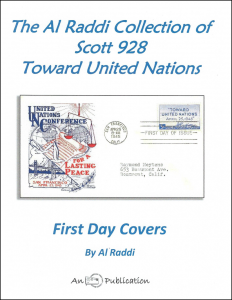 A new book from the American First Day Cover Society shares a collector’s love for the 1945 U.S. stamp that heralded the formation of the United Nations. The Al Raddi Collection of Scott 928 Toward United Nations Conference FDCs shows more than 170 different first day covers and related items for the issue commemorating the meeting of delegates from 50 countries toward the end of World War II.
A new book from the American First Day Cover Society shares a collector’s love for the 1945 U.S. stamp that heralded the formation of the United Nations. The Al Raddi Collection of Scott 928 Toward United Nations Conference FDCs shows more than 170 different first day covers and related items for the issue commemorating the meeting of delegates from 50 countries toward the end of World War II.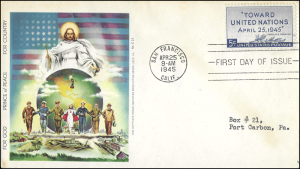 The book starts with a brief history of the conference, and then information about the stamp.
The book starts with a brief history of the conference, and then information about the stamp.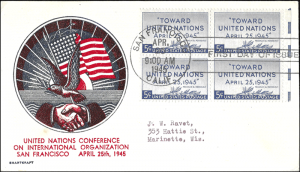 The American First Day Cover Society is a not-for-profit educational organization, with 501(c)(3) tax-exempt status granted by the IRS. Established in 1955, the AFDCS also publishes handbooks, catalogues and its award-winning bimonthly journal, First Days. It also promotes first day cover exhibiting, both at its own Americover show and at other stamp shows.
The American First Day Cover Society is a not-for-profit educational organization, with 501(c)(3) tax-exempt status granted by the IRS. Established in 1955, the AFDCS also publishes handbooks, catalogues and its award-winning bimonthly journal, First Days. It also promotes first day cover exhibiting, both at its own Americover show and at other stamp shows.

